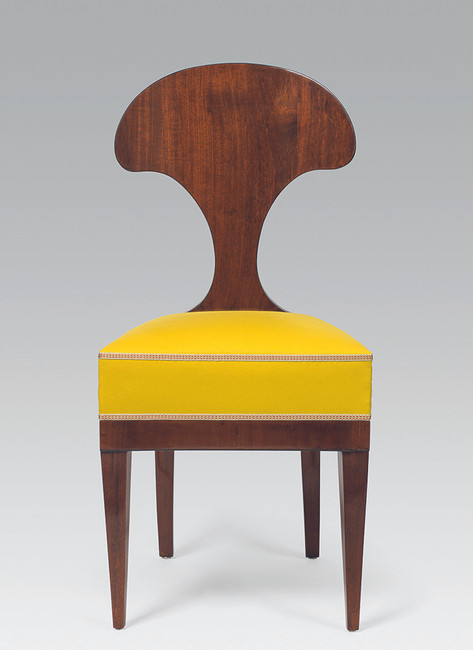From Biedermeier to the Fin de Siecle Styles
- Gen de Art

- Nov 4
- 4 min read
“Lack of ornamentation is a sign of spiritual strength.”
In the world of design and crafts, two prominent cultural movements instilled a tremendous impact on the social lifestyle in Europe from the early 19th to the early 20th centuries. The modern style of the fin de siecle was developed in Vienna in the late 19th century, stressing utility and functionality. The phenomenon was preceded by the earlier Biedermeier style, which fostered delicate craftsmanship and profound propensity for nature-inspired motifs.

Running until December 17th this year at the Panasonic Shiodome Museum of Art, “Viennese Style: Biedermeier through Fin de Siècle, Design of Living, An Invitation to the Theatrical City, Vienna” expounds on these two emerging trends, culminated as the Viennese Style, and analyzes the distinct characteristics of diverse products, from silverware, ceramics, glassware, jewelry, fashion, to furniture.
The exhibition examines the resplendent Biedermeier period, which covered the time between the Congress of Vienna (1814-1815) and the Revolution in 1848. Shadowed by political repression, people resorted to the inward nourishment of the private self and domestic culture. Viennese craftsmanship flourished, generating simple, geometric forms, humble decoration, and precise handiwork. Ornamentation was subdued and represented themes of nature and flora. Strong influences also stemmed from Emperor Joseph II's Enlightened reforms, the Freemasonry, classicism from Pompeii, the coming of the Industrial Revolution, and radical changes in design leading to the Neo-Baroque style.
In the Silverware section, teapots, candlesticks, casseroles, water vessels, and other utensils symbolize the ultimate presence of the middle class at that time. The silver Teapot (1802) by Jakob Krautauer shows a clear, rounded, and functional form in classical symmetry.
“Gesamtkunstwerk,” the “total work of art,” witnessed striking similarities in the Biedermeier and the fin de siecle styles. Both movements were founded on the purpose of day-to-day living, practicality, and straightforward aesthetics. By comparing the Samovar (1838) and Centerpiece (1924–25 ) by Josef Hoffmann, we see close resemblances in the gently looped handles and polished curves emitting timelessness.

Hoffman joined Koloman Moser as co-founder of the Wiener Werkstatte (Vienna Workshop, 1903-1932), which established Gesamtkunstwerk as the integration of architecture, furniture, clothing, and everyday tools. It shied away from unsystematic mass production, instead fusing high-quality craftsmanship guided by utilitarian and pragmatic design. Other displayed works by Hoffman include the Goulash Dish (1907), a champagne cup, wine decanter and glasses, and a Box and Vase from 1920, among others, illustrating colorfully painted flower patterns and figures.

The Glassware area showcases cylindrical tumblers and colored glasses with applied cut-glass technique, some enhanced with gold leaf, inscriptions, and landscape paintings. A deep emerald green Cup and Saucer set (1818) by the Vienna Porcelain Manufactory beams elegantly with slender, petal-motif patterned designs.
Women’s fashion design during these two eras evolved towards daily life usage by the middle class. The mode avoided exaggerated brightness and leaned more on streamlined grace and dignity. Fashion plates reveal high waistlines, puff sleeves and pale, pastel colors. At the same time, flat and fancy lines of the Secession movement blend nostalgia with modern sophistication. A silk kimono-style Dress (Textile “Biel”, 1928) by Max Schnischek in multicolored squares and rectangle patterns denotes the evident inclination towards geometric motifs.
With the formation of the textile department in 1910 at the Vienna Workshop, female artists and designers multiplied across the fields of decorative ceramics, cloisonné, jewelry, bags, hats and other accessories. Fashion designer Emilie Flöge (1874-1952), actress Eugenia Primavesi (1874-1962), and journalist Berta Zuckerkandl (1864-1945) were important women linked with the Vienna Workshop. Felice "Lizzie" Rix-Ueno (1893–1967) was an Austrian textile, wallpaper and craft designer, and student of Hoffmann. She is well-known in the Japanese craft industry due to her residence in Kyoto, where she created a wide range of significant works, particularly in textile design. On view is a remarkable Cloisonné box “Circus with Horses I” (c. 1950, reproduced in 1987), adorned with animal, human and flora elements.

In architecture and interior design, the Biedermeier look imbued clarity, inexcessive embellishment, stable furniture forms, and refined materials with finishes delineating beautiful wood grains, as shown by a striking yellow-upholstered chair with a wooden arched back from c. 1820. Wallpaper was usually faint-toned with stenciled decorations. Approaching the fin de siecle, Koloman Moser (1868-1918), Otto Wagner (1841-1918), Josef Frank (1885-1967), and Adolf Loos (1870-1933) were highly distinguished figures. Moser was one of the foremost artists of the Vienna Secession who pioneered graphic design, decorative arts like stained-glass and furniture, and interior design in the early 20th century. His Armchair (1903) in black and white checkered woven upholstery, supported by repeating, vertical slats is an iconic mark of early 20th century modern design. Wagner, as seen by his sleek black-framed armchair (1906) and dark brown finished desk and stool (1904), advocated the “utility style” (Nutz-Stil) void of eclecticism. .
Visitors will be delighted to spot an oil painting and drawings by Gustav Klimt (1862-1918) who was also a founding member of the Vienna Secession movement and helped define the Art Nouveau style in Europe.
The galleries are also surrounded by wonderful textile wallpaper and display cases by leading textile design studio, NUNO. The patterns reconstruct the aesthetic sense of the Viennese Style.
Details
“Viennese Style: Biedermeier through Fin de Siècle, Design of Living, An Invitation to the Theatrical City, Vienna
Panasonic Shiodome Museum of Art
Until December 17, 2025
10:00-18:00 (Open until 20:00 on November 7, December 5, 12 and 13)
Closed on Wednesdays (except December 17)
Written by Alma Reyes








